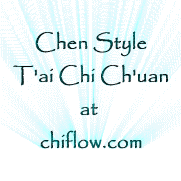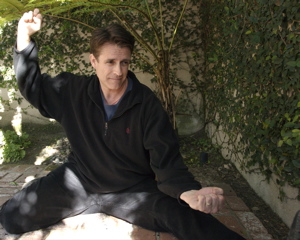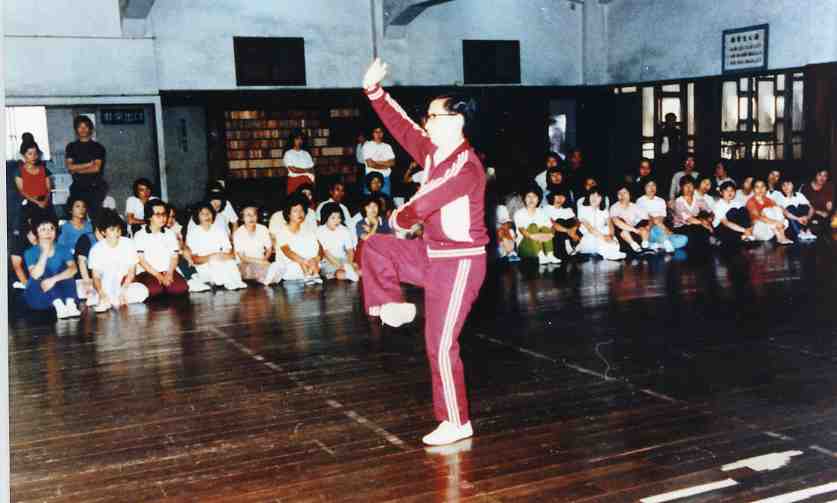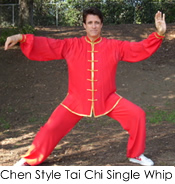According to research of historical records conducted by Gu Liu Xin, during the mid 1500's Qi Jiguang developed a set known as 32 forms of boxing. Today sets of 80, 108 or more forms typically refer to the number of individual postures. The numbering of 32 forms in Qi's set probably had a different meaning from the one we use today. Often these older sets had one name for an entire section or set. Like the Chen set, Qi Jiguang's set started with Lazily Belting the Clothes and Single Whip. Qi Jiguang supposedly took the forms and knowledge of 16 different martial arts schools to develop this Mother form.

by Gerald A. SharpChen Style Taijiquan (Tai Chi Chuan) Part 3: The Practice of Chen style
Animated Image on Left: Gerald A. Sharp demonstrates a martial application of Chen Style: "Six Sealing, Four Closing"
 Taijiquan (T'ai Chi Ch'uan) is a branch of the traditional internal martial arts (or Nei Jia Kung Fu) that spread widely in China over 300 years ago at the beginning of the Qing Dynasty. It became very popular starting around 1911 in Beijing. Stories abound about how this martial art we now call Taichichuan may have developed around the eighth century.
Taijiquan (T'ai Chi Ch'uan) is a branch of the traditional internal martial arts (or Nei Jia Kung Fu) that spread widely in China over 300 years ago at the beginning of the Qing Dynasty. It became very popular starting around 1911 in Beijing. Stories abound about how this martial art we now call Taichichuan may have developed around the eighth century.
Continued From Chen style Tai Chi Chuan Part 2
Animated Image: A demonstration of the "Silk Reeling Energy" component of the style in this transition to Chen's "Single Whip."

|
1. Internal Kung Fu Power So how do Chen stylists maximize their art and develop joint and internal power? The answer lies in the training of the Chan Su Jing, or Silk Cocoon Reeling. You don't need to do special exercises necessarily, although the exercises that were handed down by Chen Fake and Chen Zhaokwei with further development by both Feng Zhiqiang and Ma Hong are invaluable. However, to borrow a phrase from the Yang Style Taijiquan camp, "it's all in the form." If the practitioner employs patience, slowness, and softness and is able to connect their central and peripheral nervous systems with the spiraling and twisting inherent in the Chen traditional form they will likely benefit from the process. The key word is patience. Without that, you're running in circles. Chen Taijiquan can be very powerful, but if results are sought over engaging in the process, you may not only end up on the wrong track, but damage your back, energy, knees, etc. With improper practice, such as moving first from the waist or seeking power and explosive force in the movements, you will also expose your center to those who know how to use lightness in applications.
|
2. Patience First, Ask Questions Later
To avoid such injuries and dubious or unproductive practices, patience must be the banner that leads the process. Later, utilizing correct support from the center will arise followed by a strong internal structure and a flexible base in the hips. Together with this intuitive understanding of body structure, the correct use of the limbs will further emerge. The limbs are used for both gathering up and circulating the energy. Advancing to a higher level will not happen without this integral knowledge of how the structure works with both the origin and the twisting dynamics of the spiraling force. Regardless of the outward power you display, high level Chen style requires patience and softness in order to not only allow internal dynamics to emerge, but furthermore how to listen and react with sensitivity and internal strength can also be understood. Sadly though, the descendants and students of some of the highest level of practitioners ignore both patience and softness. Therefore, the question that emerges is: Why do so many of the modern day Chen T'ai Chi stylists practice something so less intricate, so much more external than other styles of Taijiquan? Why is most modern Chen style so different from Yang, Hao, or Wu Styles? It's as if the Chen style that is demonstrated today by many has become a completely different style (certainly a much more external style by comparison.). The answer rests with the practitioners themselves. The individual chooses how to practice the form and carry forth the art, and without patience and sensitivity, the sophistication of Chen Style's dynamics are farther from reach then they need be. That's why it can be highly beneficial to stand still and connect with your own spiraling energy and balance that with quietness that also exists within. Focusing on the internal dynamics may help to draw attention to patience and further discover its intrinsic value. The twisting ought to come from within regardless, and standing in zhanzhuang (standing like a post) helps to greatly turn the attention inward instead of outward. Then moving into the form or chan su jin exercises become an extension of that which is being cultivated within and not something outside of that process. In this light, it is worthwhile to see that placing patience first, lowers the affective filter in learning what is essential and helps get the practitioner on the best footing possible as they begin or continue their study of Chen Style Taijiquan. |
|
3. The Process and Patience
Taijiquan, regardless of style, has suffered from watered down and faulty transmissions. The difference between Chen style and other Taijiquan styles in this regard is that there are so many Chen stylists that idolize the snappy movements they recognize from karate and external styles of martial arts. This is not to say that Karate is bad by any means, but it is a very different sort of martial art from Taijiquan. Even within the various styles of Karate there are those who practice the traditional art and others who practice something easier or more commercial. Some Chen stylists are absolutely in similar groups. Generally the nontraditional Chen stylists are the same people who believe that something slow and intricate is useless. They do not perceive that a lack of emphasis on push hands is leaving out half the training. This group has an excessive desire to see overt training that involves heavy perspiration and heavy-handed looking blows, thinking Taiji application is built on strikes and speed, and, as such, they can revere and label the practice as "martial." This doesn't mean that the external aspects of the Chen style have no value whatsoever. For some, the external aspects must be fully understood before more intricate, subtle internal aspects can be appreciated. That's why I say it is a process. A process, however, made more difficult at the outset if the external is overvalued and patience and precision are ignored. Therefore, the intricate details of the movements, movements which are built on patience, must be carefully examined for internal martial arts to be developed. |
4. An Internal Martial Art
Chen style teacher Zhou Yuan Long. An emphasis on patience is not the only thing that makes Chen Style internal. By employing patience and relaxation in the process, then the development of chi can take place. After all, that is what makes it an internal practice. There are two types of chi: breath, or that which you can see, and that which you cannot see but can sense. With patience and relaxation you can enhance that which you can see, and develop the sensitivity for that which you cannot. |
|
5. Tournaments and Competitions
Another factor that I feel has had negative effects on the modern practice of Chen Style Taijiquan as an internal martial art is the tournament scene. Especially in America, the way tournaments are currently run has denigrated the style and reduced it to an all out show of force. The tournaments reward the external showmanship rather than promoting the patient development of the inner workings of this advanced, sophisticated art.
Contrary to popular belief, this is even more evident where legitimate Masters are judges. The reason is, is the practitioners are not interviewed or truly tested as to their ability to apply the forms they are doing. The competition often reduces to a popularity contest between schools with backroom politics between teachers playing a major role/ Some tournaments tout that they can judge what a student is capable of doing, while others say if there's a question about a student's knowledge that they will be consulted by the panel of judges. What we see is a lot of last minute political maneuvering, and instead of encouraging a more progressive format that will move forward the art, they play follow the leader and the instructor du jour's students are favored. In my view, often both the competitors who come to learn and the judges who truly know how to apply their art (beyond the instinctual level) are victims of a system that continues to breed and value "best of show," rather than "best of go." This continued distortion of reality has done more harm than good not just for Chen Style Taijiquan world-wide, but all other internal martial arts as well. |
6. Push Hands is Taijiquan Application The core training methods were established by Chen Wangting over 350 years ago. Consider studying with teachers who emphasize softness, humility, and less of themselves. Furthermore, and more importantly, choose a teacher who not only knows martial applications but the medicinal (or, Chi Kung) applications of the forms as well. At the core of Taijiquan training in all styles, including Chen, is the sophistication afforded by intricate Push Hands training. Those who dismiss Push Hands as a mere training exercise to "real fighting," don't understand how Taijiquan is applied. However, when I say Push Hands, I don't mean a lot of ridiculous pushing and shoving around, where knowing the "rules" or "tricks" advances your level. The Push Hands I am referring to is soft, yet dense, precise, yet cannot be sensed. High level Taijiquan practice with applications has a unique place in the world of martial arts. Those who have learned a Chen Style form, and then are taught competition San Shou or external Arts applications as a way of applying the art are grossly mislead. Furthermore, mixing martial arts is another huge mistake in the long run. Each complete martial art, external or internal, needs no mixing. Instead, what is needed is a commitment and perseverance to learn the essence of the art. Learning as much as possible about the many facets of a particular system is enough to fill many years.
|
|
7. Derivatives of Chen Style Actually, authentic applications of the Chen Style are non-existent in many instances. This can also be said for many of the so called classic examples associated with many styles, not only Chen, both modern and traditional. The example application and form at the top of this page, Six Sealing and Four Closing, comes just before Single Whip. While there are many applications for each of the forms, the Chen Style is not the only style to use Chan Su Jing, or silk reeling in application. The application very often demonstrated for Six Sealing and Four Closing as well as application often demonstrated in the transition to Single Whip of other styles uses a pressing or strike, when it is the transitory movement, which is very often a circling, spiraling, or twisting that is practiced in the form and ought to be considered when carrying out any application.
Chen style teacher Zhou Yuan Long. |
8. Will the Real Chen, Please Stand Up?
So the real Chen Style doesn't depend on lineage or whether your style came from Chen Xiaowang, Chen Zhenglei, Chen Fake, or Chen Zhaokwei. The most important thing to consider is the same thing you ought to be getting in other Taiji styles practice, and that is is your organism being challenged enough and benefitting from practice that is leading you into greater use of your joints and connective tissue and less into a reliance on muscles and outward force. While some practitioners may sense an enormous amount of energy and force by leaping around and utilizing explosive force, the bottom line, is the effectiveness of such training may be useless against people who are not thrown off by a show of force and train to conceal their force. Concealed strength combined with a strong central equilibrium is crucial in advancing any Taiji style and for Chen Style it is everything, if it is to maintain its integrity amongst the multitude of styles and martial arts that train as effectively in developing internal power, a strong central equilibrium, and the ever important concealed strength.
Click the Red Arrow to go back to Chen Style, Part 2 or the Green Arrow to go on to Yang Style Tai Chi, Part 1 |










